| |||||
| Decades: | |||||
|---|---|---|---|---|---|
| See also: | |||||
The following lists events that happened during 1886 in New Zealand.
| |||||
| Decades: | |||||
|---|---|---|---|---|---|
| See also: | |||||
The following lists events that happened during 1886 in New Zealand.
The 9th New Zealand Parliament continues.
The first recorded game of Women's cricket in New Zealand takes place in the Nelson district. [5]
The New Zealand Bowling Association is formed with twelve clubs. Only two clubs (from New Plymouth and Auckland) are from the North Island which will eventually lead to the events of 1891. [5] A national championships is held but the winners are not recorded. [6]
The Wairarapa and Manawatu unions are formed. [5]
Provincial club rugby champions include:
Ballinger Belt – Sergeant Remington (Wanganui)
A national tennis association is convened in Hastings . [5] The first national championships take place later in the 1886–87 season. (see 1887)

The Pink and White Terraces, were natural wonders of New Zealand. They were reportedly the largest silica sinter deposits on Earth. They disappeared in the 1886 eruption of Mount Tarawera and were generally thought to have been destroyed, until evidence emerged in the early twenty-first century of their survival.
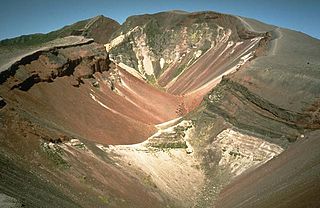
Mount Tarawera is a volcano on the North Island of New Zealand within the older but volcanically productive Ōkataina Caldera. Located 24 kilometres southeast of Rotorua, it consists of a series of rhyolitic lava domes that were fissured down the middle by an explosive basaltic eruption in 1886. While the 1886 eruption was basaltic, study has shown there was only a small basalt component to the previous recent rhyolitic predominant eruptions. This eruption was one of New Zealand's largest historical eruptions, and killed an estimated 120 people. The fissures run for about 17 kilometres (11 mi) northeast–southwest.
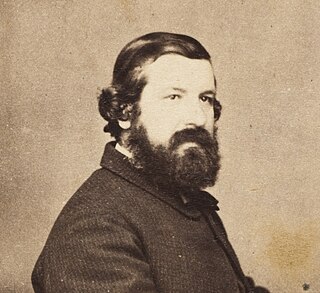
Sir Johann Franz Julius von Haast was a German-born New Zealand explorer, geologist, and founder of the Canterbury Museum in Christchurch.

Christian Gottlieb Ferdinand Ritter von Hochstetter was a German-Austrian geologist. In 1857 he was appointed geologist on the Austrian Novara expedition to New Zealand, collecting natural history specimens and producing the first geological map of New Zealand.
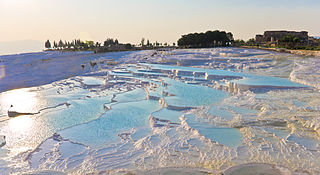
Pamukkale, meaning "cotton castle" in Turkish, is a natural site in Denizli Province in southwestern Turkey. The area is famous for a carbonate mineral left by the flowing of thermal spring water. It is located in Turkey's Inner Aegean region, in the River Menderes valley, which has a temperate climate for most of the year.

Te Wairoa was a village close to the shore of Lake Tarawera near Rotorua, New Zealand. The village was buried by volcanic ash in the 1886 eruption of Mount Tarawera. It was later excavated and is now open as a tourist destination, the Buried Village. The nearby Wairere Falls are also a tourist destination.

Lake Rotomahana is an 890-hectare (2,200-acre) lake in northern New Zealand, located 20 kilometres to the south-east of Rotorua. It is immediately south-west of the dormant volcano Mount Tarawera, and its geography was substantially altered by a major 1886 eruption of Mount Tarawera. Along with the mountain, it lies within the Ōkataina Caldera. It is the most recently formed larger natural lake in New Zealand, and the deepest in the Rotorua district.
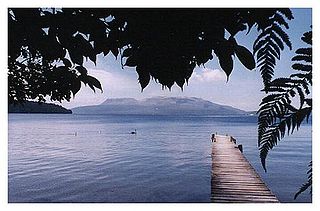
Lake Tarawera is the largest of a series of lakes which surround the volcano Mount Tarawera in the North Island of New Zealand. Like the mountain, it lies within the Ōkataina Caldera. It is located 18 kilometres (11 mi) to the east of Rotorua, and beneath the peaks of the Tarawera massif i.e. Wahanga, Ruawahia, Tarawera and Koa. Tarawera means "Burnt Spear", named by a visiting hunter who left his bird spears in a hut and on returning the following season found that both his spears and hut had been turned to ashes.

Saturnia is a spa town in Tuscany in north-central Italy that has been inhabited since ancient times. It is a frazione of the comune of Manciano, in the province of Grosseto. Famous for the spa which gives it its name, its population is 280.
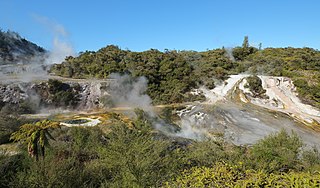
Orakei Korako is a highly active geothermal area most notable for its series of fault-stepped sinter terraces, located in a valley north of Taupō on the banks of the Waikato River in the Taupō Volcanic Zone, New Zealand. It is also known as "The Hidden Valley".
The following lists events that happened during 1887 in New Zealand.
The following lists events that happened during 1885 in New Zealand.
The following lists events that happened during 1881 in New Zealand.
The following lists events that happened during 1877 in New Zealand.
The following lists events that happened during 1870 in New Zealand.

Alfred Henry Burton is a nineteenth-century New Zealand photographer.
George Dobson Valentine (1852–1890) was a Scottish photographer.
The region around the city of Rotorua, in New Zealand's North Island, contains several lakes which have a total area of about 250 square kilometres. The term Rotorua lakes is ambiguous as it has been used historically for a New Zealand administrative area. From biggest to smallest, these are Lake Rotorua, Lake Tarawera, Lake Rotoiti, Lake Rotomā, Lake Okataina, Lake Rotoehu, Lake Rotomahana, Lake Rerewhakaaitu, Lake Rotokākahi, Lake Okareka and Lake Tikitapu. There are also smaller lakes including: Lake Okaro, Lake Rotokawa, Lake Rotokawau and Lake Rotongata. Most of the lakes have formed due to volcanic activity and some have current geothermal activity. The region is part of the Taupō Volcanic Zone, the world's most active area of explosive silicic volcanic activity in geologically recent time.
Charles Blomfield was an English-born artist who executed paintings of New Zealand landscapes, including the Pink and White Terraces, a notable natural feature that was later destroyed in the 1886 eruption of Tarawera.
![]() Media related to 1886 in New Zealand at Wikimedia Commons
Media related to 1886 in New Zealand at Wikimedia Commons